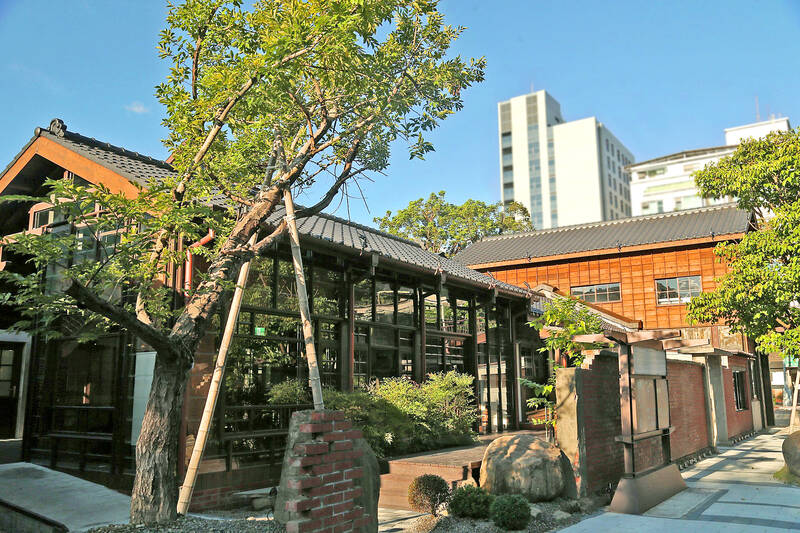As you’re wandering around the lively Dongmen MRT station neighborhood in Taipei, you may stumble upon a cluster of old-fashioned Japanese-style buildings. With their wooden frames, red brick walls, and peaceful gardens, they paint a beautiful scene and create a vivid contrast with their concrete neighbors. Easily accessible from the station, these buildings are a hidden treasure for history lovers and casual visitors alike.
These elegant structures highlight Taiwan’s rich and layered past. Constructed during the Japanese colonial period between 1895 and 1945, they initially functioned as residences for personnel of the nearby Taipei Prison. Following the end of World War II, they were transformed into accommodation for government officials, military officers and civilians.
However, the passage of time took its toll, and these historic buildings fell prey to neglect and decay. In response, the Taipei City Department of Cultural Affairs initiated the Old House Cultural Movement Plan in 2013. This is a comprehensive restoration project aimed at preserving these sites and boosting repair and reuse efficiency. Additionally, the result adds a touch of beauty to the urban landscape and provides cultural and creative groups with event spaces.

Photo courtesy of Rongjin Gorgeous Time Park on Facebook / 照片:翻攝自臉書Rongjin Gorgeous Time Park
Today, the restored buildings invite visitors to experience a slice of history while participating in various leisure activities. Among these buildings is the fascinating Rongjin Gorgeous Time Park. Here, visitors can immerse themselves in exhibitions that bring the past to life, sign up for DIY courses that spark creativity, and indulge in delicious food at the on-site restaurants. Whether you’re feasting on authentic Japanese cuisine or sipping relaxing afternoon tea, you’re guaranteed a memorable experience.
So, next time you find yourself near Dongmen MRT station, seize the opportunity to explore these pieces of cultural heritage and see for yourself how historic preservation meets modern adaptation.
當你漫步於臺北市捷運東門站附近的熱鬧街區時,你可能會偶然發現一片古老的日式建築群。這些建築有木架、紅磚牆和寧靜的庭園,描繪出一幅美麗的景象,並與其周圍的混凝土建築形成鮮明對比。這些建築能從捷運東門站輕鬆抵達,對於歷史愛好者和隨興參觀的遊客來說都是隱藏的寶藏。
這些優雅的建築凸顯了臺灣豐富而層疊的過去。這些建築建於西元1895 年至1945年的日本殖民時期,最初用來當作附近臺北監獄人員的住所。第二次世界大戰結束後,它們被改建成政府官員、軍官和市民的住宅。
然而,時光的流逝造成了損害,這些具有歷史意義的建築淪為疏於維護和慘遭衰敗之下的犧牲品。作為回應,臺北市文化局於西元2013年啟動了《老房子文化運動計畫》。這是一項全面的修復計畫,旨在保護這些場所並提高修復和再利用的效率。此外,這項成果為城市景觀增添了一抹美感,並為文創團體提供了活動場所。
如今,這些經過修復的建築邀請遊客來體驗歷史的一部分並同時參與各種休閒活動。在這些建築當中的,就是引人入勝的榕錦時光生活園區。在這裡,遊客可以沉浸於讓過去栩栩如生重現的展覽、報名參加激發創造力的手作課程,並在園區現場就有的餐廳品嘗美味的食物。無論你是享用正宗的日本料理還是啜飲輕鬆的下午茶,都一定會獲得一段難忘的體驗。
因此,下次當你在捷運東門站附近時,不妨把握機會探索這些文化遺產,親眼看看歷史保護如何與現代適應相結合。
MORE INFORMATION
gem n. 寶石;珍貴的人或物
comprehensive adj. 全面的;詳盡的
boost vt. 提升;推動;改善
adaptation n. 適應(能力)
1. cluster n.(同類物聚集的)一群
KEY VOCABULARY
1. cluster n.(同類物聚集的)一群
I see a cluster of people on that dock—the fishing must be good over there.
我看到一群人在那碼頭上─那邊的漁獲一定不錯。
2. frame n. 支架;框架
The construction team carefully built the steel frame of the skyscraper before adding glass windows.
施工團隊在加上玻璃窗之前精心建造了摩天大樓的鋼架。
3. colonial adj. 殖民(地)的
Haiti became free of colonial rule in 1804; it was once ruled by France.
海地於西元1804 年脫離殖民統治;該國曾被法國統治過。
4. personnel n. 全體人員;員工;人事部門(單複數同形)
Since the outbreak of the war, over 10,000 military personnel have been stationed in this area.
自從戰爭爆發以來,已有超過一萬名軍事人員駐紮在這個區域。
5. civilian n. 平民;老百姓
During the war, civilians were called into the army and made to fight for their country.
戰爭時期,平民百姓被徵召入伍,為國奮戰。
6. fall prey to 深受……所害;成為……的犧牲品
Many people fall prey to online fraud due to their lack of awareness about Internet security.
很多人因為缺乏網路安全意識而成為網路詐騙的受害者。
7. decay n. 腐蝕;衰敗
This building was once very beautiful, but it has fallen into decay.
這棟建築曾經很漂亮,但它現在已經破敗不堪了。
8. restoration n. 修復;恢復;歸還
restore vt. 修復;恢復;歸還
Several talented artists are working on the restoration of this famous painting.
幾位才華橫溢的藝術家正努力修復這幅著名畫作。
9. site n. 地點;位置
on-site adj. 現場的;就地的
There has been a school on this site for over 100 years.
有一所學校已經在這個地點存在一百多年了。
學習音檔: https://magazine.english4u.net/Magdata/menu/3dust
《空中美語》雜誌APP免費下載: https://www.english4u.net/apps/index.aspx
免費收聽當月《空中美語》雜誌課文朗讀及解析 !
文章由AMC空中美語授權使用: https://www.english4u.net

A: When is the Lantern Festival? B: The festival is celebrated on the 15th day of the first month of the lunar calendar, which fell on Feb. 12 this year. A: Oh no! Did I miss the 2025 Taipei Lantern Festival? B: Yes, you did. But you can still go to the 2025 Taiwan Lantern Festival in Taoyuan, which will run until this Sunday. A: Let’s go admire the exuberant lanterns. A: 元宵節到底是哪一天? B: 就是農曆1月15日啊,今年則落在國曆2月12日。 A: 喔不,我是不是錯過了2025台北燈節? B: 是的,但你還可以去桃園的2025台灣燈會,活動將持續至週日。 A: 那我們去欣賞豐富的花燈秀吧! (By Eddy Chang, Taipei Times/台北時報張聖恩)

Every February, the small town of Ptuj in Slovenia comes alive with the vibrant celebration of its famous carnival. This festival, with its deep historical roots, is a cherished tradition where local residents come together to ward off the winter cold and embrace the arrival of spring. Participants dress up in furry costumes, transforming into kurenti, mythical monsters believed to drive away evil spirits and bring good fortune for the new year. Although the exact origins of the Ptuj carnival remain a mystery, it is firmly rooted in ancient Slavic and Illyrian cultures. The modern form of the carnival

A: What’s the theme of the 2025 Taiwan Lantern Festival’s main lantern? B: The theme is “Paradise,” and the main lantern is a snake-shaped “infinity” symbol that features a lighting show every half an hour. A: Cool, I heard that there are over 300 lanterns. B: There are even giant lanterns in the shape of Pikachu and some other popular Pokemon characters. A: Let’s go now. A: 2025台灣燈會主燈的主題是什麼? B: 主題是「無限樂園」!主燈的造型則是蛇形的數學「無限號」,主燈每半小時還有一次燈光秀。 A: 酷喔,聽說總共有300多件花燈作品。 B: 甚至還有皮卡丘和其他熱門寶可夢角色的巨型花燈呢。 A: 哇我們現在就出發吧! (By Eddy Chang, Taipei Times/台北時報張聖恩)

本文由生成式AI協作,本刊編輯編修。 Tucked away in southwestern Taiwan, Yunlin County is a treasure trove of cultural heritage, rich history, and natural beauty. From its stunning temples and glove puppetry to historical architecture and picturesque landscapes, Yunlin rewards those who venture off the beaten path. Yunlin is renowned for its flourishing temple culture. Temples in this region are not merely places of worship but also communal centers where people gather for festivals, rituals, and social functions. One of the most notable temples here is the Beigang Chaotian Temple, which was built more than 300 years ago and is dedicated to Matsu, the sea